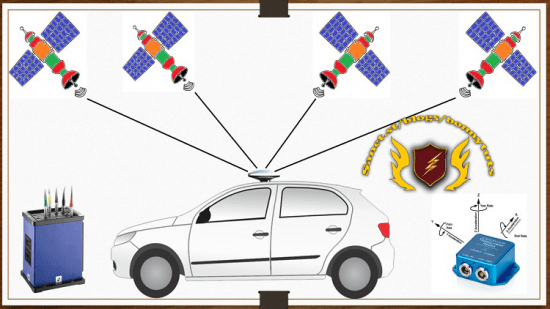
Published 2/2023
Created by Suchit Kr
MP4 | Video: h264, 1280×720 | Audio: AAC, 44.1 KHz, 2 Ch
Genre: eLearning | Language: English | Duration: 59 Lectures ( 10h 57m ) | Size: 5 GB
D-GNSS, DGPS, RTK, PPP, SBAS, GBAS, AHRS, Accelerometer, Gyroscope, Magnetometer, Python, fusion, Raspberry-pi 4
What you’ll learn
GNSS (Global Navigation Satellite Systems) in detail together with its role in ADAS and Autonomous vehicle test and development
Hands on with GPS sensor and raspberry pi 4 using python to receive real-time GPS data
Exploring various applications of GNSS based systems in automotive and non-automotive industry
Hands on with 3 axis accelerometer and 3 axis gyroscope with raspberry pi 4 and python
GNSS based correction methods – Differential GNSS, DGPS, SBAS, GBAS, RTK, PPP in detail
Foundation of accelerometer, gyroscope and magnetometer with mathematical insights
Understanding IMU – Inertial Measurement Unit and its importance in INS (Inertial Navigation System)
Getting deeper (only theoretical) into GNSS and INS based fusion using Kalman filter based approaches.
Details of AHRS (Attitude and Heading Reference System) and Dual GNSS / INS system
Multiple case-studies covering various fusion techniques (theoritical) and applications with GNSS and INS
Additional reference material in form of research litertures and web-links
By the end of this course, you will be confident to use GNSS/INS based sensor system for your ADAS / Autonomous vehicle test and validation in your work.
Requirements
Computer with internet connection
Motivation to study and learn new technology
(optional) low cost raspberry pi and GPS, IMU sensor for hands on practice.
Description
Sensors are an indispensable part of Advanced Driver Assistance Systems (ADAS) and Autonomous Driving (AD) Technology. Sensors – like cameras, radar, lidar and ultrasonic are well known to all. These sensors are used to do external environmental perception around the vehicle and in some cases also to do in-vehicle perception. GNSS (Global Navigation Satellite System), GPS (Global Position System) together with INS (Inertial Navigation System) are used to find the location of the ego vehicle itself. These sensors are used for multiple applications in the ADAS and the AD industry. These applications include but are not limited to:1. Localization of vehicles on the road2. To generate ground truth data for sensor perception (radar, lidar, camera) validation3. To generate ground truth data for sensor fusion validation4. For validation of various ADAS functions in the deterministic test sites5. For using the GNSS/GPS highly accurate time – as a reference clock to synchronize (using NTP, PTP or gPTP) multi-sensor systems for algorithm development.6. In V2X (Vehicle to Other) and V2V (Vehicle to Vehicle) applications.and many more…….GNSS/GPS + INS sensors also have multiple applications in various non-automotive fields like Navigation with mobile phones and cars, in Rail transport – to track locomotives, in aviation – for aircraft navigation from departure to landing, in marine – to track and navigate ships, in Port Automation, Precise Agriculture, Surface mining, Surveying, Drones, Smart Infrastructure application, etcAs GPS/GNSS alone cannot provide centimetre-level accuracy (which is necessary for ADAS and AD applications), various add-on technologies are used1. DGNSS (Differential GNSS)2. DGPS (Differential GPS)3. SBAS (Satellite Based Augmentation System)4. GBAS (Ground Based Augmentation System)5. RTK (Real Time Kinematic)6. PPP (Point Precision Positioning)Moreover, Inertial Navigation Sensors – Accelerometer, Gyroscope and Magnetometer are also used with GPS /GNSS for better localization and accurate measurement, especially in situations where a GNSS signal is unavailable. This includes 1. Inertial Navigation systems (INS), 2. GNSS-aided INS system, 3. AHRS (Attitude and Heading Reference System), 4. Dual GNSS (or GNSS compass) -aided INS system.In this course, you will learn all of the above-stated technologies so that you will be able to use them in your work and/or projects. In addition, hands-on practice in measuring real-time GPS and IMU data using low-cost sensors with raspberry pi 4 and python3 is included.Through this complete course which consists of 9+ hours of videos, you will learnBasics of ADAS (Advanced Driver Assistance systems) with some examplesBasics of AD (Autonomous Driving) together with SAE levels of automationBrief understanding of various sensors like Radar, lidar, camera, and ultrasonic used in ADAS and AD.Lots of applications covering the usage of GNSS + INS sensors in ADAS and AD industry as well as non-automotive domainsVarious GNSS + INS devices available in the market (ranging from high cost to low cost)Deeply understanding GNSS technology, signal processing, pseudo-range calculation, trilateration, GNSS errors, different ways to overcome these errorsVarious types of coordinate systems and frames used in GNSS technologyWhat are latitude and longitude? Different ways to represent them and their inter-conversionsNMEA-0183 message structures for GPS measurementReal-time GPS measurement using a low-cost GPS device, raspberry pi 4 and python 3.Various Differential correction methods – DGNSS, DGPS, SBAS, GBAS, RTK, PPPUnderstanding IMU (Inertial Measurement Unit) and then deep dive into the working of accelerometer, gyroscope and magnetometerReal-time IMU measurement using a low-cost IMU with raspberry pi 4 and python 3Understanding INS (Inertial Navigation System) using a case study of pedestrian dead reckoning using INSDeep dive into AHRS (Attitude and Heading reference system), GNSS-aided INS technology and Dual GNSS-aided INS technology.Further case studies were taken from research papers to understand applications of GNSS and INS (along with other sensors) in ADAS, AD and robotics.Note: This course focuses more on understanding the concepts and provides insights into various technologies in this domain hence programming is intentionally kept to a minimum. Disclaimer: All the reference videos taken from various sources are only used for educational purposes and there is no intention to infringe copyright.
Who this course is for
Anyone interested to learn and understand GNSS INS based measurement technology use for position, speed, time and heading estimation
People involved in ADAS and Autonomous vehicle development – it is highly recommended to do this course
Password/解压密码www.tbtos.com
转载请注明:0daytown » GNSS GPS IMU INS Sensors – for ADAS and Autonomous Vehicles